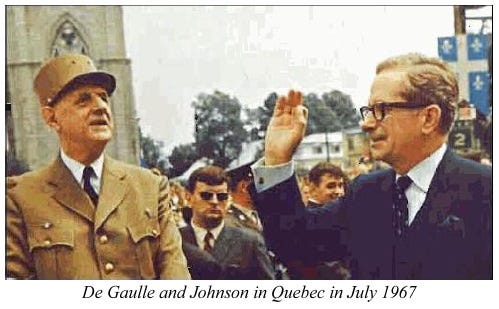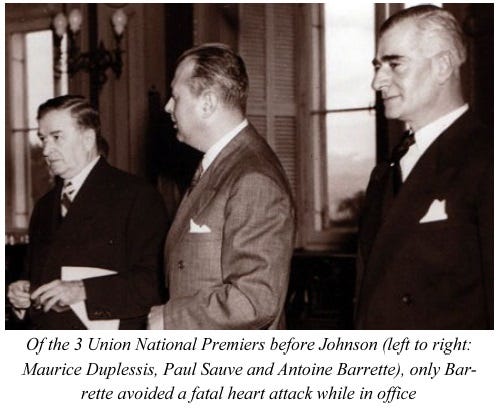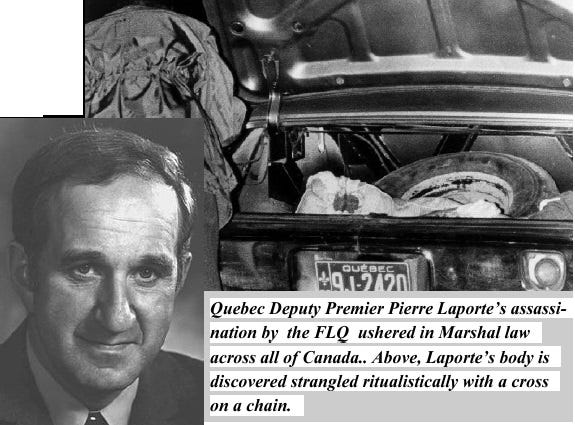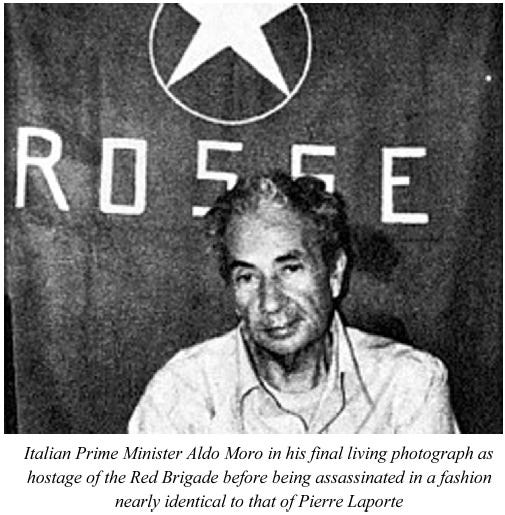This is the second of a two part series first published in a 2013 edition of the Canadian Patriot Review alongside French journalist Benoit Chalifoux
The list of structures and institutions that follows shows clearly that some in official circles had anticipated the October 1970 crisis, which crisis had been concocted to lead into the War Measures Act and a consolidation of power in the hands of the “new technocratic elite” that had taken control of the Quiet Revolution after the death of Quebec Premier Daniel Johnson in 1968 and the ouster of both Jean Lesage and Charles de Gaulle from political power in 1969.
The purpose of the following report, which relies heavily upon accounts by Pierre Vallières, taken from his 1977 book L’exécution de Pierre Laporte, les dessous de operation Essai (Editions Quebec-Amériques, 1977) , is not to establish the cause of the October Crisis, but to sufficiently demonstrate that the official narrative commonly used to explain this period is not true. Not only that, but as the facts will show, the cause of these terrible events were organized by more powerful institutions both within and above the Canadian government.
It is also necessary to hold in mind that not only was no autopsy ever conducted on the body of Premier Daniel Johnson Sr. upon his mysterious death in 1968 (which President de Gaulle undoubtedly understood in its ugly detail before suffering his own color revolution in 1969), but neither did the body of Johnson’s ally Pierre Laporte receive any autopsy after his murder during the October Crisis which we document below.
At the Federal Level (Ottawa)
Based in Ottawa, the Strategic Operations Centre (SOC), was the channel from the army to the Trudeau Government. Its existence became publicly known only in 1975, like that of the Centre national de planification des mesures d’urgences (C.N.P.M.U.), that worked closely alongside the SOC. In the light of what we now know, one can well imagine that the tasks of those centres was to draft, and implement, scenarios that could lead to promulgating the War Measures Act.
Establishment of the Comité du 7 May 1970: set up by the Federal Government in the wake of the elections on April 29th 1970, as we shall shortly see. The decision was disclosed only on December 23rd 1971, by the Toronto daily The Globe and Mail.
In Quebec
Opération Essai (Operation Trial), derived from an initial plan, first drafted in 1960, by the Planning and Operations Section of the Quebec Command. That same year, 1960, Jean Lesage became head of the Quebec Government, and launched the «Quiet Revolution» which was a process that had a bipolar character. This process became a key battle ground between two opposing forces. The first had aimed at installing a technocratic elite in Quebec while secularizing the province in preparation for a new Malthusian culture that could be reconstructed to the will of the oligarchy. The opposing force was represented by those nation-building, largely Catholic forces then centered around Lesage and Daniel Johnson who desired to direct the revolutionary energy then embracing Quebec around an anti-imperial strategy of republicanism and technological progress.
1966: the Infantry, Air Force and Navy were regrouped, and a new Mobile Army Command was set up at the Federal Military Base of Saint-Hubert.
1969: the Mobile Army Command set up its Civil Emergencies Section, whereby contacts with the army were to be restricted to carefully selected political figures.
7 June 1970: Michel Côté, the City of Montreal’s Head of Litigation, was secretly appointed to head the Combined Anti-terror Team – Escouade combinée anti-terroriste or C.A.T.. His job was to keep an eye on Jean Drapeau, then Mayor of Montreal.
Chronology of the October 1970 crisis
The chronology below challenges the official thesis, and points up a great many contradictions.
1966: Daniel Johnson is elected Quebec Premier giving the anti-Malthusian catholic forces a new opening to regain their lost power on the continent. This coincides with the rise of Robert F. Kennedy to greater prominence in preparation for his 1968 announcement of his plans to revive his brother`s policies in his bid for the Presidency.
1967: Charles de Gaulle visits Quebec on Johnson’s invitation at which point deals are struck between the two leaders based on advanced technology, infrastructure, space technology and cultural programs. Many components of this arrangement were based upon the French-Quebec assistance of technology and training to former African colonies now gaining their independence. The French President was invited to return at the end 1968 for the Francophone Summit.
26th September 1968: Daniel Johnson dies under unusual circumstances mere hours before the unveiling ceremony of the Manicouagan-5 Dam that Johnson had put into motion a decade earlier alongside then Premier and nation builder Paul Sauvé. Officially, he suffered a fatal heart attack. By 1969, De Gaulle is forced out of office in an anarchistic mock referendum in France. De Gaulle himself had survived over 13 assassination attempts run largely by the Montreal-based Permindex which was also at the center of the assassination of President Kennedy in 1963. Two of the three previous Union National Premiers before Johnson met identical fates and died of heart attacks while in office in a period of 6 months. Maurice Duplessis died on September 7, 1959, while Paul Sauvé died on January 2, 1960.
1968: Daniel Johnson’s two greatest enemies: Pierre Trudeau and Rene Lévesques, both agents of the of the technocratic reforms of the Quiet Revolution steered by Georges Henri Lévesque’s Université Laval are set up to polarize Canada between two false notions of nationalism and install a new form of Malthusian power structure on both provincial and federal levels. Trudeau is set up as Prime Minister and Lévesques founds the Parti Quebecois (two weeks after Johnson’s death), later to emerge as Premier of Quebec (1976-85). The PQ absorbs many of the saner independence forces who advocated Johnson’s formulation of “Independence if necessary, but not necessarily independence”.
1968-1970: violent demonstrations break out in Montreal.
The Civil Emergencies Section predicts « grave disturbances » during the April elections, and states that the army might have to be called out to « protect the democratic vote ».
April 29th 1970: Provincial elections held whereby the separatists win 23% of the vote.
February and June 1970: two kidnapping plots are uncovered by the Montreal police force (police de la Communauté urbaine de Montreal, CUM). One plot, to be launched in June 1970, was to be an FLQ attack on the US Consulate, launched by FLQers Lanctôt and Marcil.
27 May 1970: an article in La Presse appears, on the army’s rôle in putting down civil disturbances in Canada. According to the article, military operations were be run out of the Saint-Hubert base.
In Pierre Vallières’ view « by late summer 1970, everything was in place, and liaison between the army and the police forces concerned had moved onto a weekly, sometimes daily basis ». He adds that « by June, the contents of the October manifesto had already been printed in some newspapers, following the abortive ‘Lanctôt-Marcil’ plot against the US Consulate; the FLQers demands had become known, and, finally, the FLQ’s operational bases (save for the flat rented in September in Northern Montreal by Cossette-Trudel) had been dismantled or had become known to the police. The FLQ-1970 was under control in October, and no surprise was possible ».
James Cross is kidnapped
5th October 1970: the British diplomat James Cross is kidnapped. The police’s first step is to go straight to the Greek Consul’s place of residence! The kidnappers’ trace is lost. The kidnappers demand that the FLQ’s manifesto be published, and that their political prisoners be freed.
7th October: one o’clock in the afternoon. Mrs. Cross is shown police photographs and identifies Jacques Lanctôt as one of the kidnappers.
8th October: the FLQ manifesto is published, but negotiations continue over the freeing of political prisoners.
Pierre Laporte is kidnapped: the crisis intensifies
10th October (five forty in the afternoon): the Quebec Justice Minister announces that the authorities have decided to categorically reject the demands made by Cross’ kidnappers, nor will they free the political prisoners
10th October (six eighteen in the afternoon): Pierre Laporte, Vice-Premier of Quebec and Minister of Labour and Immigration, is kidnapped in front of his home, just as he was about to play ball with his nephew. Pierre Laporte was second in command of the Quebec Government, and as such, was, allegedly, afforded special police protection. But the first thing the police did – having been notified of the kidnapping within two minutes of the event – was, yet again, to go straight to the wrong place!
Vallière reports that « the six eyewitnesses of the kidnapping of Pierre Laporte (his nephew, his wife and their neighbours) are unanimous: the kidnappers were ‘clean cut’ and well dressed, a fact sergeant Desjardins confirmed to journalists that evening (…) Another witness, who worked in a petrol station on Taschereau boulevard, stated that shortly before the Minister was kidnapped, strangers had asked him how to get to rue Robitaille. ‘I thought they were policemen’, he said, because one was carrying something that looked like a walkie-talkie’ ».
Night of October 12th to 13th: the Army Mobile Command sends an emissary to Quebec’s Justice Minister, Jérôme Choquette, demanding he sign, in the name of the Bourassa cabinet, a letter requiring intervention by the armed forces. The cabinet was not then prepared to sign, and Choquette announces he would continue his efforts to persuade the reluctant elements.
15th-17th October: « for appearances’ sake» the Canadian Parliament debates the opportunity of proclaiming the War Measures Act. The Opposition puts up a show of protest until Saturday October 17th. Pierre Laporte’s body is thereupon discovered, « proving » a posteriori that the measures unleashed on October 16th had been needful.
15th October (two in the afternoon): the Canadian army begins to deploy in Quebec, at Bourassa’s request.
15th October (nine in the evening): Bourassa ups the ante, and lays down a six-hour deadline for the kidnappers to hand over James Cross and Pierre Laporte.
16th October (in the night): Quebec Premier Bourassa signs a letter written by Federal Justice Minister Marc Lalonde, instituting the War Measures Act. Several thousand soldiers were already deployed in the streets of Quebec and in the Federal Capital Ottawa. Through the War Measures Act – whose application need not be voted up by Parliament and that has NEVER been abrogated since – the curfew came down, civil liberties were suspended, and, inter alia, search of private domicile without warrant became lawful. Over four hundred people were arrested.
16th October (four in the morning): Meeting in Council, the Governor General, the Queen’s direct representative in Canada, approves the proclamation of a state of emergency, pursuant to which the War Measures Act comes into force automatically.
17th October (four in the afternoon): a member of the Cell that calls itself “Dieppe (Royal 22°)” (this is the name of a French Canadian regiment but that was not, oddly enough, at Dieppe in WWII, where many French Canadians died) calls into the CKAC radio station. Purportedly, this is a third and heretofore unknown FLQ cell. The caller announces that Pierre Laporte has been murdered. The earlier communiqués had all come from the FLQ cell known as Libération, that held James Cross, and that spoke on behalf of the Chenier Cell, the members of which were presumed to be the Pierre Laporte’s kidnappers. The Libération cell, that seemed to find the “Dieppe (Royal 22°)” business disturbing, put out a communiqué at mid-day, calling upon the press to blow the whistle on a “montage” (coup monté) by the Federal Government. The police prevented that communiqué from being published until December 8th.
Pierre Laporte’s body is found in the boot of the very car used to kidnap him (witnesses had taken down the car’s registration number at the time) later in the evening on the Saint-Hubert military base (!), right next to the Army Mobile Command. Given the prevailing State of Emergency, who, I ask, could have driven the car onto the base without being stopped and searched ? Credibility is stretched well beyond the breaking point here.
In the hours following on the death of Pierre Laporte, the authorities put out a description of Paul Rose and Marc Carbonneau, but not that of Jacques Rose, Francis Simard or Bernard Lortie. Paul Rose, Jacques Rose and Francis Simard (presumed to be members alongside Bernard Lortie of the Chénier cell, while Marc Carbonneau and Jacques Lanctôt were part of the Libération cell holding James Cross) had been on police files and monitored since no later than 1968. The three had been in Texas (or perhaps Mexico) since September 1970, and had raced back to Quebec after James Cross was kidnapped. The many trips by Chénier cell members during the time Pierre Laporte was held (and the temporary gaoling of Jacques Rose and Francis Simard between October 15th and 17th) lead one to presume that it could only have been someone quite different keeping watch over the Minister, and that the actual role played by the cell in kidnapping and murdering him was secondary, perhaps even notional.
19th October: the house where Pierre Laporte was held and murdered, or so goes the official thesis, is « discovered »: 5630 rue Armstrong at Saint-Hubert, near the aforesaid military base bearing that name. That very house had been ransacked by police whilst the Minister might have been there, but nothing was turned up. Bourassa told Mrs. Laporte on 14th October that the police had found the place her husband was being held: « he will be freed within hours, we await the opportunity to do so without endangering [him] ». The question remains: was that safehouse 5630 rue Armstrong ?
2nd November: the Federal Minister John Turner proposes an Emergency Measures Bill, based on the War Measures Act. The Emergency Measures Act was voted up on December 1st and came into force for five months.
3rd December: the Emergency Measures Act is signed into law by the Queen. The crisis was, at least apparently, over. Why the fresh Emergency Measures ?
At that very moment, James Cross is freed, and his kidnappers in the Libération cell are given a safe-conduct to Cuba.
Late December: Paul and Jacques Rose, as well as Francis Simard are arrested. The coroner’s report is based upon unsigned confessions. Paul Rose never acknowledges, not even verbally, the confession attributed to him. Although he was actually firmly in police custody at the time, to avoid any risk whatsoever that he spill the beans in open Court, he was, unbelievably, tried in absentia !
31st March 1971: Paul Rose, Bernard Lortie and Francis Simard are sentenced to life imprisonment. Jacques Rose, who was tried later, was acquitted. The Prosecution Service declines to appeal. Jacques Lancôt and Marc Carbonneau were already in exile in Cuba.
If we are to go by the explicit terms of the War Measures Act, the entire country was about to go down in murder and mayhem. The truth is rather different: the FLQ was a tiny, two-cell organisation with a total membership of about ten ! But we read, at Article 2 of the War Measures Act:
“EVIDENCE OF WAR
The issue of a proclamation by Her Majesty, or under the authority of the Governor in Council shall be conclusive evidence that war, invasion, or insurrection, real or apprehended exists and has existed for any period of time therein stated, and of its continuance, until by the issue of a further proclamation it is declared that the war, invasion or insurrection no longer exists.”
Until 1970, the War Measures Act, first promulgated in 1914, had been proclaimed only twice before: when Canada entered the World War I, in 1914, and World War II, in 1939. Here, we are to take the Governor General’s personal opinion, as “conclusive evidence” of a State of War, that absolutely did not exist.
What did the victim himself think about all this? All that is known for certain, is that in none of his letters to Robert Bourassa whilst kidnapped did Pierre Laporte ever refer to the FLQ, nor did his wife, or most of his friends, ever buy the official story. A Royal Mounted Canadian Police (RCMP) report dated March 3rd 1971 states that Mrs. Laporte’s opinion was that the authorities had executed her husband.
There is a dreadful similarity between the Laporte kidnapping and murder, and that of former Prime Minister Aldo Moro in 1978, down to the detail of the police wandering about in circles in the vicinity of the safehouse. In both cases, subsequent events show that the real intention was never to free the kidnap victim, but to use the crisis to shift the balance of power in the country, in favour of rentier-finance interests.
The Material Ease of Terrorists
It is rather astonishing that so many players from that time, have risen to positions of material ease and social prominence. Precisely at the point the synarchy has launched a fresh wave of strategy of tension in Europe and the Americas, they appear to want to keep a tight grip on the main players in the events of October 1970, in order to avoid their disclosing what really went on.
Ex-FLQer Jacques Lanctôt now owns his own publishing house, with a large stock-in-trade on cultural, sociological and psychological issues, and essays on the separatist movement. On March 28th 2004, Télé-Quebec broadcast a documentary called Hostage (Otage), comprised of interviews with Jacques Lanctôt, who kidnapped James Cross, and the Cross family. The documentary was finished in early 2004. Lanctot is now a leading journalist with Canoe Inc. which is owned by Quebecor (whose Vice Chairman is none other than Brian Mulroney)
From 1996 to 2002, Paul Rose had achieved such a miraculous boost of success that he became the head of the Quebec wing of the New Democratic Party of Quebec! This Party merged with the Union des Forces Progresistes which in turn merged with two other organizations to become Quebec Solidaire which currently holds 7.6% of the seats in Quebec’s National Assembly. On March 14, 2013 Quebec Solidaire spokesman MP Amir Khadir introduced a resolution into the National Assembly to honour Paul Rose.
CSIS’s ‘Trudeau Files’ Erased in 1989
On June 15, 2019 the strange fact was made public by Canada’s National Post that the entire 40 year CSIS/RCMP dossier compiled on Canada’s most famous Prime Minister, Pierre Elliot Trudeau was destroyed by Canada’s top spy agency… in 1989.
How this embarrassing fact could have gone un-noticed for so long is tied to access to information laws in Canada which make all government dossiers available on any public or private citizen 20 years after their deaths. In 2019, historians searching for a story filed early applications to read this long awaited dossier which was supposed to be awaiting scrutinizing eyes in the Archives of Canada. The answer they received from CSIS and the National Archives was that the massive treasure of documentation was destroyed because it did not “meet the threshold set out by the CSIS Act to justify being kept in service’s active inventory. The file also fell short of criteria for preservation set out by the national archives”.
Based upon the facts laid bare in the above text and earlier report, it can safely be said that the true reason for CSIS’s destruction of the Trudeau Files had everything to do with devastating information on the role played by Canada’s third longest standing Prime Minister within the context of Britain’s geopolitical “Great Game” against the world.
The role his son is playing as a pawn within this Great Game in carrying out the dictatorial legacy begun by his father 50 years ago can only be understood from this vantage point.
Matthew Ehret is the Editor-in-Chief of the Canadian Patriot Review , and Senior Fellow at the American University in Moscow. He is author of the ‘Untold History of Canada’ book series and Clash of the Two Americas. In 2019 he co-founded the Montreal-based Rising Tide Foundation .








I clearly remember this 'Crisis' and felt at the time that there was something much bigger going on. After all these years, thanks to you, Mr. Ehret the facts have been revealed to me. You have confirmed my belief that the current 'Crisis' is one and the same. I despair that the world will never be rid of these murderous evildoers. They thwart the good and creative progress of humanity... BRI is the way!